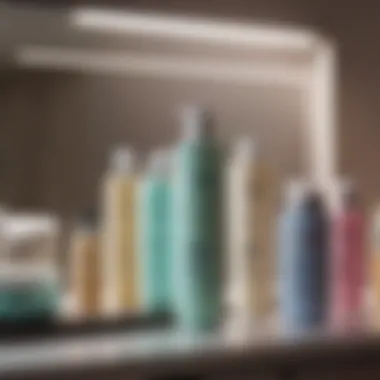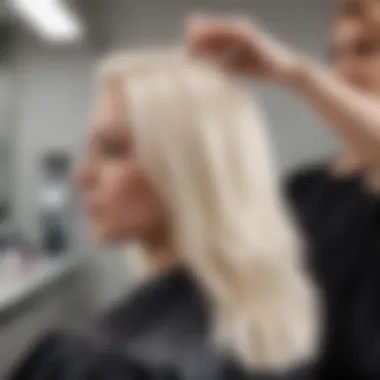Assessing the Cost of Hair Bleaching: A Comprehensive Examination


Intro
Hair bleaching has become a common trend for many women looking to freshen up their appearance or embrace a new style. However, the financial implications of this change can vary significantly based on several factors. It is not merely about the initial product costs or salon fees; it extends beyond that to include maintenance, hair type considerations, and long-term health of the hair. Therefore, a comprehensive examination of these aspects is essential for anyone considering a shift in their hair color.
In the discussion that follows, we will break down the various dimensions involved in assessing the cost of hair bleaching. This guide will help you navigate through the complexities of pricing while allowing you to make informed choices that align with your aesthetic goals and budget. As such, understanding the nuances of hair bleaching can help prevent any emotional or financial missteps in your beauty journey.
Understanding Hair Bleaching
Hair bleaching is a process that alters the natural color of hair, making it lighter and more vibrant. In this article, the significance of understanding hair bleaching is pivotal. It serves as the foundation for women who are considering a transformation in their appearance. By grasping the nuances of the bleaching process, individuals can make informed choices that align with their aesthetic goals while also safeguarding their hair health.
Prelims to Hair Bleaching
Hair bleaching works by breaking down the natural pigment in hair, known as melanin. This process involves using a bleaching agent, often containing hydrogen peroxide and ammonia, to lighten the hair. It is essential to note that bleaching can cause damage to the hair structure, leaving it porous and fragile. Understanding these properties helps in weighing the risks versus rewards of such a significant change.
Moreover, the technique requires precision. Mistakes can result in uneven colors, unwanted tones, or even hair breakage. Hence, awareness about the chemical processes, potential effects, and necessary aftercare is crucial for anyone considering this treatment.
Common Reasons for Hair Bleaching
Women choose to bleach their hair for various reasons. Some of these include:
- Fashion Trends: Many are influenced by current trends in beauty. Celebrity styles often promote lighter shades, prompting a desire for change.
- Personal Reinvention: A new hair color can signify a fresh start or a personal transformation. This is especially true during significant life changes.
- Expressing Individuality: Hair is a form of self-expression. For some, bleaching hair is a way to showcase their personality or artistic side.
- Concealing Gray Hair: For women dealing with graying hair, bleaching can be an appealing option to create a more youthful appearance.
Ultimately, understanding these reasons provides clarity on why hair bleaching is prevalent in contemporary beauty culture. This comprehension becomes an essential part of determining how one might approach their own hair journey.
The Financial Aspects of Bleaching
Understanding the financial implications of hair bleaching is crucial for anyone contemplating this transformative process. Hair bleaching is not just an aesthetic decision but a significant investment in one’s appearance and self-confidence. This section explores the monetary factors associated with hair bleaching, focusing on three essential aspects: the initial costs of products, the expenses of professional services, and a comparative analysis of home versus salon bleaching methods. Each element carries its own merits and considerations, making it important to fully grasp the financial landscape before embarking on this journey.
Initial Cost of Hair Bleaching Products
The first step in achieving that desired shade of blonde or any lightened hue involves selecting the right bleaching products. These products typically include bleach powder, developer, and toners, among other items. When shopping for these materials, pricing can vary significantly based on brand and quality. Top brands such as Wella, L’Oréal, and Schwarzkopf offer products at different price points.
- Bleach Powder: Prices can range from $5 to $30 per container, depending on the brand and volume.
- Developer: This secondary product usually costs between $5 and $15.
- Toners: These can add another $10 to $25 to your total.
The initial investment in quality products is essential. Higher-quality products may be more expensive but often provide better results and cause less damage to the hair. Ultimately, a budget of around $20 to $70 could be expected for initial home bleaching supplies depending on desired quality and quantity. It's also wise to include potential costs for additional tools like brushes, bowls, and gloves, which can range from $5 to $15.


Cost of Professional Bleaching Services
Seeking professional help for hair bleaching comes at a higher cost but offers significant benefits. Professional hairstylists have the expertise to apply bleach safely and effectively, reducing the risk of hair damage and ensuring even color distribution. The cost of professional services can vary widely based on factors such as location, salon reputation, and stylist experience.
In general, here’s what you might expect:
- Basic Bleaching: An average straightforward bleaching session can range from $75 to $150.
- Additional Services: If you require special techniques like balayage or highlights, prices can increase to between $150 and $300.
Investing in a skilled professional may seem expensive, but it can be more cost-effective in the long run. Skilled application may result in longer-lasting results and reduce the frequency of touch-ups needed. Moreover, a professional may advise you on the most suitable products for your specific hair type.
Comparative Analysis of Home vs. Salon Bleaching
When deciding whether to bleach your hair at home or seek salon services, it is important to evaluate both financial and personal factors. Here are some considerations:
- Cost-Effectiveness: Home bleaching may seem cheaper at first glance, with initial costs of products typically amounting to a fraction of salon pricing. However, multiple attempts, repeated purchases, and possible product waste can inflate this initial savings.
- Risk vs. Reward: Professional results often outweigh the savings achieved at home. Those new to bleaching may find it challenging to achieve even color and may inadvertently harm their hair. Professional stylists also possess knowledge of the chemical processes involved, greatly reducing risks.
- Time Investment: Home bleaching may require more time for research, planning, and execution, whereas salon visits offer a quicker, more streamlined experience.
Thus, while home bleaching may be financially appealing initially, the potential for damage and the cost of corrections can lead to higher expenses over time.
"Choosing between home and professional bleaching involves evaluating both financial implications and personal experience with hair care."
In summary, evaluating the financial aspects of hair bleaching requires careful consideration of both initial and ongoing costs. Understanding these variables can help individuals make informed decisions that align with their aesthetic goals and financial situation.
Factors Affecting Hair Bleaching Costs
Understanding the costs associated with hair bleaching goes beyond just the initial expenses. Various factors significantly influence the total cost. Each factor must be examined carefully, as it helps potential clients form realistic expectations about their financial commitment to hair transformation. Knowing these aspects can lead to informed decisions that balance aesthetic desires with budget constraints.
Hair Length and Density
The length and density of hair are key elements that directly affect the cost of bleaching. Longer hair requires more product and potentially more time in a salon setting. Additionally, hair density comes into play. Thicker hair needs more bleach solution to achieve desired results compared to finer hair.
- Product Quantity: Longer or denser hair generally demands a greater volume of bleach. This means more substantial material costs.
- Application Time: Stylists often charge based on the duration of the treatment. Longer sessions equate to higher service fees.
- Special Techniques: More elaborate techniques, like ombre or balayage, may require additional time, raising costs.
It’s crucial for anyone considering hair bleaching to assess their hair characteristics and prepare for the implications regarding pricing.
Hair Type and Texture
Hair type and texture have a profound impact on the bleaching experience and outcome. Different hair types absorb bleach at varying rates, which affects how treatment is administered and how costs are structured.


- Curly vs. Straight: Curly hair may take longer to process, often resulting in higher costs. In contrast, straight hair may handle bleaching more efficiently.
- Porosity: Hair with high porosity tends to absorb bleach faster but may also undergo more damage, requiring additional care treatments, which can increase expenses.
- Ethnic Differences: Hair structure varies across ethnic backgrounds, prompting different approaches and sometimes additional costs related to specialized techniques or products.
Awareness of these factors can guide individuals in selecting the right services and understanding their needs for their hair type.
Desired Color and Technique
Another pivotal factor affecting the cost of hair bleaching is the desired color and the techniques used. Different shades and styles demand various levels of skill and product usage.
- Color Complexity: Going from a dark color to a lighter shade typically involves multiple steps, raising both product and service costs.
- Techniques: Techniques like highlights or full-bleach jobs differ significantly in pricing. Highlights often cost less, whereas a full bleach job is a more extensive process.
- Consultations: Many salons offer consultations to better assess the client’s goals, which may incur fees as well.
Ultimately, selecting the right color and technique involves a careful balance of desired outcomes versus financial expectations.
Understanding these factors enriches the decision-making process and shapes the overall experience of hair bleaching, ensuring a holistic approach to beauty and self-care.
Maintenance and Follow-Up Costs
Understanding maintenance and follow-up costs is essential for anyone considering hair bleaching. After the initial process, the hair requires ongoing attention and care. This ensures that the color remains vibrant and the hair does not suffer significant damage. Proper maintenance is not just about keeping the aesthetic appeal but also protecting the overall health of the hair. The following subsections address the various components of these costs, emphasizing their importance in the broader conversation about hair bleaching.
Regular Touch-Ups: Frequency and Cost
Regular touch-ups are a necessity for maintaining the integrity of bleached hair. As natural hair grows, the roots will start to show their original color, creating an unpolished appearance. Typically, the frequency of touch-ups ranges from every four to eight weeks, depending on how fast the hair grows and the desired look.
The cost of each touch-up can vary significantly. In a salon setting, prices might range from $50 to $150 or more, influenced by factors such as hair length, salon location, and stylist expertise. Home touch-ups can reduce costs, as at-home kits often range from $10 to $40. However, this requires a degree of skill and caution to avoid mishaps.
Special Hair Care Products
After bleaching, hair requires specific care to remain healthy. Specialized hair care products are vital in this regimen. These products often include color-safe shampoos and conditioners, deep conditioning masks, and leave-in treatments formulated for bleached hair. Investing in high-quality products may seem expensive upfront, but they can prolong the lifespan of the color and improve hair health.
For instance, a bottle of color-safe shampoo may cost around $20, while deeper treatment masks can be in the range of $30. Choosing the right products can make a substantial difference in both appearance and health.
Impact of Bleaching on Overall Hair Health
Hair bleaching has a significant impact on hair health. The process involves the removal of natural pigments and can lead to dryness and brittleness. Therefore, understanding this impact is crucial for anyone undergoing bleaching. Users should be aware that maintaining healthy hair post-bleaching will incur additional expenses, such as regular trims and specialized treatments.
To mitigate potential damage, consider the following factors:
- Hydration: Incorporate professional deep conditioning treatments regularly to restore moisture.
- Protection: Use heat protectants when styling to minimize additional damage from heat tools.
- Trims: Regular trims every 6 to 8 weeks help in removing split ends, which tends to occur after bleaching.


In summary, ongoing costs associated with maintenance and follow-ups are significant. These costs serve a dual purpose: ensuring artistic maintenance while also preserving the health of the hair. Neglecting these factors can lead to costly repairs and further damage in the long term. Understanding these elements allows for a more complete evaluation of the overall investment in hair bleaching.
Assessing Long-Term Financial Commitment
Understanding the long-term financial commitment of hair bleaching is essential for anyone considering this beauty treatment. Hair bleaching can yield striking aesthetic results and significantly alter one's appearance. However, the financial implications should not be underestimated. Each decision made in the bleaching process can affect future expenditures, upkeep, and overall satisfaction with hair health.
Cost-Benefit Analysis of Hair Bleaching
Conducting a cost-benefit analysis is a fundamental step to grasp the overall impact of hair bleaching. This analysis involves assessing current costs against the benefits of enhancing one’s look. Here are some key points to consider:
- Initial Costs vs. Outcomes: Weigh the costs of bleach, developer, and hair care products against the satisfaction received from the new look.
- Frequency of Maintenance: Hair treatments often required post-bleaching can add to overall costs. Multiple touch-ups may be necessary for maintaining color vitality.
- Potential Savings: Evaluate if enhancing your aesthetic appeals translates into personal or professional gains, such as improved confidence or social opportunities.
This analytical approach empowers individuals to make informed decisions that align with their financial realities.
Evaluating Potential Damage versus Aesthetic Appeal
The decision to bleach hair must also consider the balance between potential damage and the aesthetic appeal it brings. Here are elements to ponder:
- Impact on Hair Health: Hair bleaching can cause dryness, breakage, and other damage. Assessing the trade-off between these risks and desired looks is critical.
- Long-Term Effects: Damaged hair may require more significant investments in repair treatments or specialized products, leading to increased long-term costs.
- Aesthetic Satisfaction: Consider how much value you place on your desired look. If the elevated appeal from bleaching gives a sense of happiness or boosts self-esteem, this should factor heavily into your decision.
Striking a balance between cost, care, and satisfaction helps guide individuals toward making smarter, informed choices about hair bleaching while safeguarding the health of their hair.
In summary, assessing the long-term financial commitment associated with hair bleaching is not only about immediate expenses but also about understanding future implications. Taking the time to perform a thorough cost-benefit analysis enables one to appreciate the trade-offs involved, thus facilitating well-informed choices.
Finale
The conclusions drawn from an analysis of hair bleaching costs underline the significance of making educated decisions. A thoughtful approach not only aids in understanding the financial implications but also promotes awareness of the best practices for maintaining hair health post-bleaching. As the desire for lighter hair tones continues to rise, it becomes increasingly crucial for individuals to grasp the extensive costs involved, including initial product expenses and continuous maintenance fees.
Summary of Costs Involved
A thorough examination of hair bleaching costs incorporates several elements. The cost can vary significantly based on whether one opts for at-home bleaching or professional services. Home bleaching kits usually range from $10 to $50, while professional services can range from $75 to $300 or more, depending on the salon's reputation and location. Here are some notable costs associated:
- Initial product expenses: Hair bleaching kits, including developer and bleach powder.
- Professional services: Consultation and application by trained stylists.
- Maintenance costs: Regular touch-ups and special hair care products.
Moreover, hair type and desired outcomes play a pivotal role in dictating overall expenses. Longer, thicker hair often warrants higher costs due to increased product usage and stylist labor during application. An informed assessment of these variables allows prospective clients to budget appropriately and avoid surprises.
Making Informed Choices in Hair Bleaching
Understanding the full spectrum of costs associated with hair bleaching equips individuals to make informed choices. Women should consider both the aesthetic enhancement and the financial commitment required to maintain their newly dyed hair. Evaluating various factors such as hair condition, desired shade, and longevity of color will assist in making prudent decisions. Here are key considerations:
- Evaluate hair health: Prioritize the current state of your hair. Strong hair can endure bleaching better and reduce the risk of damage.
- Research professionals: Choosing a reputable salon can lead to better results and potentially lower long-term costs due to fewer mistakes.
- Consider ongoing expenses: Factor in the frequency of touch-ups and essential hair products required for maintenance.
In summary, the journey of hair bleaching encompasses both beauty and responsibility. Clarity on costs helps foster sensible choices that ensure satisfaction with both looks and investment. An informed approach paves the way for enjoying a stunning new appearance while safeguarding one’s hair health.



